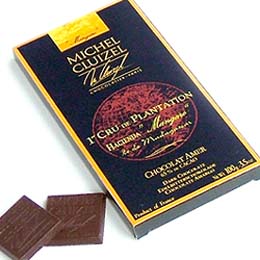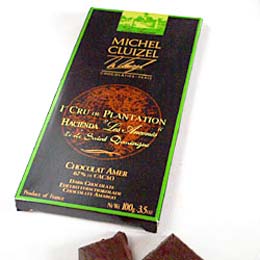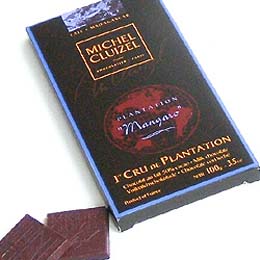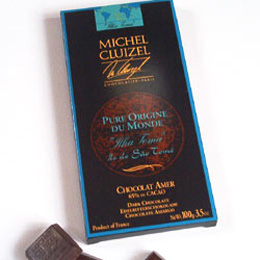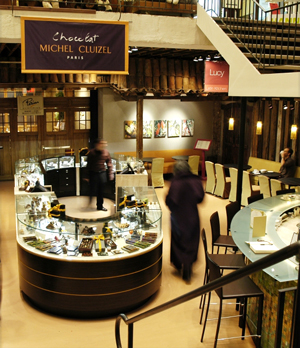|
|||||||||||||||||||||||||||||||||||||||||||||||||||||||||||||||||||||||||||||||||||||||||||||||||||||
Michel Cluizel 1er Cru Chocolates: Bar Master Of The WorldThere is a Michel Cluizel: you can see him, with an ebullient smile, on his corporate website. In 1947 his parents, pastry chefs Marc and Marcelle Cluizel, decided to venture into the world of fine chocolate. Fascinated by the chocolate business, Michel became an apprentice and has been making chocolates—which soon became exceptional chocolates—since 1948. Today, assisted by his four adult children, the chocolate shop that began in a small town in Normandy is now a global enterprise. More than 6,000 chocolatiers and patissiers use his couverture* and sell his chocolates. Yet, while many shops sell Cluizel products, there are only two Cluizel stores: the original, on the Rue Saint Honoré in Paris, and, since a year ago, in New York City. Cluizel produces a wide variety of elite chocolates beyond bars, from bonbons to novelties like chocolate sardines, cacao pods and baguettes to chocolate-covered almonds, cacao nibs and coffee beans. Our focus today is the 1er Cru de Plantation chocolates, single origin, single estate bars that come from remarkable plantations. They are revered by chocolate-lovers in the manner of great wines. The analogy is accurate, as we’ll see in a moment. What’s Different About CluizelWhat sets Cluizel apart from other world-class chocolate manufacturers is his innovative, finely
Today, Cluizel still leads the pack in innovation by redefining old origins with new flavors. The 1er Cru de Plantation line of single estate bars shows how many flavors can be found in a cacao from a single origin. Each bar is produced from cacao that was sourced from a single plantation (also called an estate or hacienda), rather than from a variety of growers within a region. This way, Cluizel is able to convey the differences of topography and environment (terroir) more articulately than by diluting the message through blending and mixing the beans of different local growers. The 1er Cru BarsWhile all of Michel Cluizel’s chocolates are tops, the top of the tops are his 1er (Premier) Cru de Plantation bars. He makes a separate tasting box of single origin cacao bars, where one can compare the differences in flavor among premium cacaos grown in the regions of the Dominican Republic, Ecuador, Ghana, Grenada, Java, Madagascar and Venezuela. He also makes delicious blended bars (more about these products below). But the 1er Cru bars are his finest product, made from the beans of the finest cacao plantations in three of these locations and two others.
[1] Les Pucelles is one of 14 Premier Cru vineyards in the village of Puligny-Montrachet. Others include Clavaillon, Le Cailleret, Les Combettes, Les Folatières and Les Perrières. There are 4 Grand Cru vineyards, which are higher-ranked than Premiers Crus: Bâtard-Montrachet, Bienvenues-Bâtard-Montrachet, Chevalier-Montrachet and Montrachet. The 1er Cru de Plantation bars offer an amazing array of flavor complexities. The cacao contents themselves vary slightly: 47% and 50% for the milk and 64%, 65%, 66%, 67% and 70% for the dark bars. This is not for the sake of diversity: each bar has the perfect percentage to bring out even the slightest traces of terroir and flavor overtones of the beans, and that happens even if the variance is only one percent.
When tasting these bars, leave behind all references from years of eating chocolate that tastes like chocolate and sugar. With Cluizel, each bar is an orchestration of flavors that come from the bean and its terroir. Some bars are a mixed fruit plate, some are exotic smokiness. Enjoy each piece slowly: let the palate savor the flavors that come welling up. It’s O.K. if you can’t identify them at first—some people can pinpoint all of the flavors immediately, others learn to recognize them over time. Here are our tasting notes, combined with some production notes from the manufacturer: Concepcion
Los Anconès
Mangaro
Maralumi
Maralumi Lait
Tamarina*
*NOTE: Due to sourcing problems, in 2007 Cluizel replaced Tamarina with another São Tomé bar, Vila Gracinda 67%. Vila Gracinda has earthy and licorice notes along with the characteristic smokiness of fine São Tomé chocolate. Pursuant to this last point, Cluizel has worked on all of the bars since their inception, as he becomes more familiar with what the cacaos can do, and brings them to his vision of perfection. It’s the measure of the chocolatier-artisan, that no matter how good something is, it can be that much better to serve both the cacao and those who love it. It’s another feature that distinguishes a family-owned concern like Cluizel from larger producers who produce a great product, but aren’t necessarily driven to the same heights of perfectionism. All 1er Cru bars come in 3.5-ounce (100g) bars as well as in individually wrapped, 5g tasting squares. Mangaro Noir 65% is available in 1.5 ounce (30g) bars, as are the 45%, 72%, 85% and 99% blended bars. Roughly 2-1/2 x 3-1/2 inches, they are the perfect portion size, in our opinion. The bite-size squares make it easy to enjoy small amounts more frequently, and to compare different 1er Crus and origin cacaos. Squares are traditionally served with an espresso, and also are the size used in chocolate tastings. While the New York store does not carry them, the tasting squares are available in 50-count bags of a single flavor and in 200-count boxes for larger tastings (or for people who enjoy a few pieces a day).
|
|
For one of the most memorable chocolate experiences imaginable, a trip to Michel Cluizel’s U.S. store, in New York City, is de rigueur. Chocolat Michel Cluizel’s New York store is the only Michel Cluizel retail store outside of Paris, and the only retail location in North America where one can find the entire collection of Michel Cluizel bonbons. In a charming space on the first floor of New York’s luxury home store, ABC Carpet & Home, the retail shop and chocolate café features the full selection of chocolate bars, a vast array of bonbons, exciting hot and cold chocolate drinks and chocolate desserts. Most wonderful are the guided tasting menus, private sessions that run from 30 to 55 minutes with an extremely knowledgeable “chocolate sommelier” who turns something exceedingly delicious into something exceptionally educational as well. Currently there are four tastings† each so worthy of attention such that visitors with only two days in New York should plan two tastings a day, in-between any other necessary activities. |
†Five are listed below, but the Introductory Tasting Paired With Three Fine Spirits can be skipped if taking the Full Spirit Tasting—highly recommended. |
- Introductory Tasting. This tasting focuses on the basics of chocolate: how to appreciate a fine piece of chocolate, the history and health benefits of chocolate, its transformation from bean to bonbon and the differences between various beans and cacao percentages. It features seven chocolates, including blended and single plantation varieties and a superlative bonbon. [30 minutes, $35 per person]
- Introductory Tasting Paired With Three Fine Spirits. An engaging and informative introduction to pairing fine chocolate with fine spirits. Three spirits are specifically chosen to harmonize with, and accentuate, the chocolates. [40 minutes $44 per person]
- Full Spirit Tasting. A more extended and thorough journey into the basics and depth of chocolate enjoyment, with emphasis on how chocolates pair with specially selected fine spirits. This tasting features eight chocolates, including blended and single plantation varieties, as well as two exquisite bonbons, paired with eight fine spirits ranging from Cognac and muscat to single-malt Scotch and tequila. [55 minutes, $100 per person]
- Champagne & Bonbon Tasting. While it sounds like Jean Harlow in “Dinner At Eight,” this serious tasting focuses on heightening one’s appreciation of fine chocolates, the art of making extraordinary bonbons and the intriguing and sensual history of chocolate. A full range of bonbons is tasted, including blended cacao and single plantation ganaches, pralines, gianduja and alcohol- and fruit-filled bonbons. Seven bonbons are paired with three varieties of French sparkling wine. [35 minutes, $60 per person, 4-person minimum]
- Cocoa‡ Across The Globe. For chocolate-lovers who want to deepen their knowledge and ability to detect subtle differences between varying cocoa beans and growing regions, this tasting compares seven 72% cacao chocolates from different countries—Ecuador, Ghana, Grenada, Java, Madagascar, Sumatra and Venezuela—along with two ganache bonbons from single plantations in the Dominican Republic and Venezuela. [30 minutes, $40 per person, $5 supplement for a glass of Muscat or Sherry]
‡THE NIBBLE uses the more accurate term cacao instead of cocoa in its writings about chocolate. But since the term cocoa is more commonly used by Americans, Cluizel has chosen that term and we have not changed it in their program description. For an extended discussion, see the terms in our Chocolate Glossary—Terms and Definitions.
While it is possible to drop in, reservations are recommended. The facility is also available for private tastings and parties. From our very first tasting, where our group of jaded food writers sat enraptured, we knew that we wanted to hold private tastings for every special occasion: birthday parties, bachelor(ette) parties, college reunions—we’d look for occasions to celebrate. Not every situation requires closing down the place for privacy. We’ve been back in choco-gaggles of two, three and four, just to introduce our friends to the fabulous “Choctails” (like nothing you’ve ever had before—trust us).
Chocolat Michel Cluizel is the first fine chocolate store in New York to hold a full liquor license, in order to serve not only bonbons that contain liquor, but the brandy, Champagne, Cognac, Port, Scotch, tequila and wine that are paired with the chocolates and included in some of the specialty chocolate beverages. For all the times that you have read that alcohol and chocolate don’t pair well, this is an exceptional opportunity to see how beautifully they do match: you just have to know how to do it the right way.
Have A Tasting At Home
You won’t have the invaluable tutelage of your chocolate sommelier, but you can conduct your own chocolate/alcohol pairing (and perhaps invite us—we’ve had it so many times, we’re almost qualified to be an assistant chocolate sommelier). This is one of the menus served at Cluizel, with spirits that specifically match the unique flavor profile of Cluizel chocolates. The chocolates can be purchased from the Michel Cluizel website.
Tasting Chocolates With Spirits
Chocolat Michel Cluizel |
Spirit |
Grand Lait 45% Blended Milk Chocolate |
Seguinot VSOP Cognac With 50% Water |
1er Cru de Plantation “Mangaro Lait” (50% Cacao), Single Origin Milk Chocolate From Madagascar |
Trimbach Grand Reserve William Pear Brandy (Poire William) |
Noir 60% Blended Dark Chocolate |
Redbreast Irish Whiskey With 20% Water |
1er Cru de Plantation “Maralumi Noir” (64% Cacao), Single Origin Dark Chocolate From Papua New Guinea |
Veuve Clicquot La Grande Dame Champagne |
1er Cru de Plantation “Mangaro Noir” (65% Cacao), Single Origin Dark Chocolate, Madagascar |
Dios Baco Oloroso Sherry |
1er Cru de Plantation “Concepcion” (66% Cacao), Single Origin Dark Chocolate from Venezuela |
Loubere Napoleon Armagnac With 20% Water |
1er Cru de Plantation “Los Anconès” (67% Cacao), Single Origin Dark Chocolate from Santo Domingo |
Mallo Cuvee Saint-Jacques 2002 Gewürtztraminer |
1er Cru de Plantation “Tamarina” (70% Cacao), Single Origin Dark Chocolate from São Tomé |
Petit Grain, Muscat de Saint Jean de Minervois |
Noir 72%, Blended Dark Chocolate |
Caol Ila 18 Year Old Single Malt Scotch, With 20% Water |
Grand Noir 85%, Blended Dark Chocolate |
J Vidal-Fleury Muscat de Beaumes de Venise 2003 |
Noir Infini 99%, Blended Dark Chocolate |
El Tesoro Paradiso Tequila |
In general, Cluizel finds that El Tesoro Paradiso Tequila and J Vidal-Fleury Muscat de Beaumes de Venise pair well with all of the chocolates.
Cacao Around The Globe Tasting
You can taste the 1er Cru bars for their differences in geographical influences upon the bean: how a great cacao will taste in New Guinea versus the Caribbean versus Venezuela, e.g.
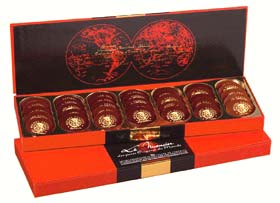 Le Nuancier Pure Origins Tasting Box. Another way to do this is to purchase the collection of 72% cacao single origin chocolate tasting discs, representing seven cacao growing regions of the world: Dominican Republic, Ecuador, Ghana, Grenada, Java, Madagascar and Venezuela. The presentation box is perfect for a party or for gift-giving. Michel Cluizel has included tasting notes for a self-guided chocolate tasting experience.
Le Nuancier Pure Origins Tasting Box. Another way to do this is to purchase the collection of 72% cacao single origin chocolate tasting discs, representing seven cacao growing regions of the world: Dominican Republic, Ecuador, Ghana, Grenada, Java, Madagascar and Venezuela. The presentation box is perfect for a party or for gift-giving. Michel Cluizel has included tasting notes for a self-guided chocolate tasting experience.
The Intensity of Cacao Tasting. Cluizel makes wonderful blended bars, combining beans from more than one origin. They allow you to taste the differences in increasing concentrations of cacao:
|
|
We are huge fans of these bars, and enjoy the Grand Noir 85% almost daily. With coconut overtones, it offers flavor excitement with just 15% sugar (compare that to Cluizel’s 45% milk chocolate bar which has 25% sugar and 30% milk powder, or to a standard commercial milk chocolate bar that’s 30% chocolate, which has even more sugar).
Not to be missed is Noir Infini, a 99% cacao bar with just .5% sugar and .5% ground vanilla. It’s essentially pure chocolate, and we encourage lovers of bittersweet chocolate to experience it. An extraordinary blend that provides a mouthful of intense bitter chocolate with creamy cocoa butter, it is intense, powerful and makes a chocolate-lover understand what is truly at the root of all this dark magic. You can buy the bars and taste them informally, but as with the origin cacaos, Cluizel has a formal solution, whether for parties or individual scholarship:
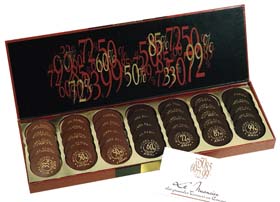 Le Nuancier Cocoa Percentages Tasting Box. As with the Nuancier tasting box of pure origin chocolates, here is a turnkey kit of tasting disks of 33%, 45% and 50% cacao milk chocolates and the 60%, 72%, 85% and 99% cacao dark chocolates. Le Nuancier Grandes Teneurs en Cacao is a beautiful presentation of 70 tasting disks that allow you to study, compare and discover your own preferred level of cacao content (you can have more than one favorite, of course!).
Le Nuancier Cocoa Percentages Tasting Box. As with the Nuancier tasting box of pure origin chocolates, here is a turnkey kit of tasting disks of 33%, 45% and 50% cacao milk chocolates and the 60%, 72%, 85% and 99% cacao dark chocolates. Le Nuancier Grandes Teneurs en Cacao is a beautiful presentation of 70 tasting disks that allow you to study, compare and discover your own preferred level of cacao content (you can have more than one favorite, of course!).
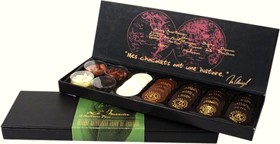 Once Upon A Bean. Il était une fève... translates to “Once Upon A Bean...,” no fairy tale but another magnificent tasting box that combines the cacao percentages disks from the previous tasting box with even more cacao fun and learning. There are also samples of cacao nibs, which are edible; and the cocoa butter and cocoa mass which are separated from the nibs and then processed into the disks (and bars, bonbons and truffles) we eat. An excellent starting-off point for beginners and experts alike.
Once Upon A Bean. Il était une fève... translates to “Once Upon A Bean...,” no fairy tale but another magnificent tasting box that combines the cacao percentages disks from the previous tasting box with even more cacao fun and learning. There are also samples of cacao nibs, which are edible; and the cocoa butter and cocoa mass which are separated from the nibs and then processed into the disks (and bars, bonbons and truffles) we eat. An excellent starting-off point for beginners and experts alike.
Each tasting box makes a perfect gift for any chocolate-lover, beginning with yourself.
Developing expertise is largely an exercise of repeatedly tasting and comparing. These tasting boxes, and the notes that come with them, are a great help in pursuing chocolate connoisseurship.
Chocolat Michel Cluizel ~ Paris
Since 1987 Chocolat Michel Cluizel, the flagship Paris store, has been one of the landmark chocolate establishments in the city. Managed personally by Catherine Cluizel, one of Michel Cluizel’s daughters, it was originally called “La Fontaine au Chocolat” after its cascading chocolate fountain. Due to perishability, certain products are only available in the Paris store. Be sure to make it a stop on your next trip:
- 201, rue Saint-Honoré
75001 PARIS
Phone: +33 (0)1 42 44 11 66
E-mail: Paris@ChocolatMichelCluizel-NA.com - Hours of Operation:
Monday through Saturday, 10 a.m. to 7 p.m.
The store is closed during the month of August.
Cacao Finale
How to sum up the chocolates of Michel Cluizel? To borrow some emotion from Jimi Hendrix’s “Are You Experienced?”: After you taste through the line of 1er Cru de Plantation bars, you will hear the trumpets and the violins. You will be experienced.
FORWARD THIS NIBBLE to anyone who loves chocolate or is looking for a sophisticated new concept for entertaining—a chocolate tasting.
MICHEL CLUIZEL 1ER cru de plantation chocolate barsConcepcion 66% (Venezuela), Los Anconès 67% (Dominican Republic), Mangaro 65% and Mangaro Lait 50% (Madagascar), Maralumi 64% and Maralumi Lait 47% (Papua New Guinea) and Tamarina 70% (São Tomé)
Buy online at |
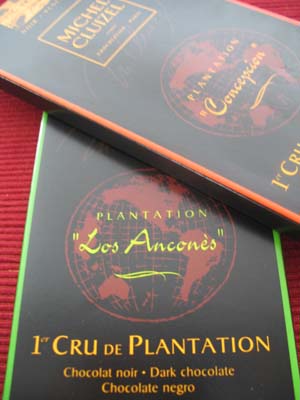 Photo by Melody Lan. |
|
The bars are also available at fine retailers nationwide and at the U.S. store: Chocolat Michel Cluizel @ ABC Carpet & Home 888 Broadway (at 19th Street) First floor New York, NY 10003 Phone: 1.212.477.7335 Fax: 1.917.591.9485 |
Read more about our other
|
Have A Favorite Chocolate?
|
| THE NIBBLE does not sell the foods we review or receive fees from manufacturers for recommending them. Our recommendations are based purely on our opinion, after tasting thousands of products each year, that they represent the best in their respective categories. |
FOR ADDITIONAL INFORMATION, special offers, contests, opinion surveys, THE NIBBLE back issues archive, product gift-finder, links to our favorite food websites, and the ability to nominate YOUR favorite nibbles, visit the home page of TheNibble.com.
Do you have friends who would enjoy THE NIBBLE? Click here to send them an invitation to sign up for their own copy. |
| Return To Index |
ABOUT THE NIBBLE. THE NIBBLE, Great Food Finds, is an online magazine plus newsletters about specialty foods and the gourmet life. It is the only consumer publication and website that focuses on reviewing the best specialty foods and beverages, in every category. The magazine also covers tabletop items, gourmet housewares, and other areas of interest to people who love fine food.
© Copyright 2004-2025 Lifestyle Direct, Inc. All rights reserved. All information contained herein is subject to change at any time without notice. All details must be directly confirmed with manufacturers, service establishments and other third parties. The material in this newsletter may not be reproduced, distributed, transmitted, cached, or otherwise used, except with the prior written permission of Lifestyle Direct, Inc.





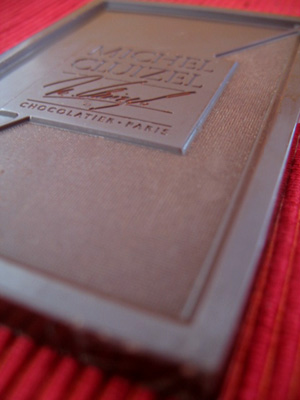
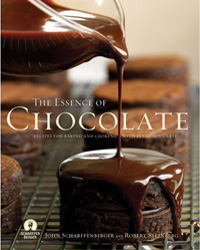
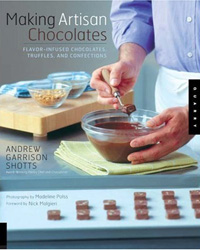
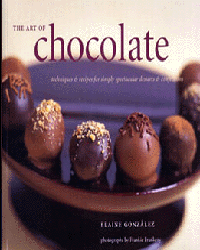
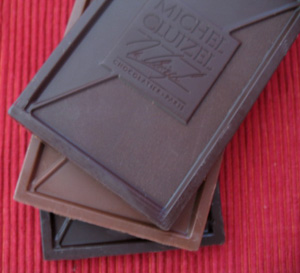 nuanced, beautifully balanced, unemulsified chocolate. An enveloping sense of refinement permeates the bars, acknowledging a chocolatier with the highest standards of excellence, who can tease the slightest suggestion of flavor or aroma from his beans. One can taste the loving care invested into the development of each particular bar. Whether in the 1er Cru line, where all beans come from a single plantation, or the blended bars, where the beans come from different points around the globe, the careful selection, roasting, blending and processing of cacao result in flavors so interesting and harmonious, pure and devoid of any trace of bitterness, that the student of chocolate is enraptured.
nuanced, beautifully balanced, unemulsified chocolate. An enveloping sense of refinement permeates the bars, acknowledging a chocolatier with the highest standards of excellence, who can tease the slightest suggestion of flavor or aroma from his beans. One can taste the loving care invested into the development of each particular bar. Whether in the 1er Cru line, where all beans come from a single plantation, or the blended bars, where the beans come from different points around the globe, the careful selection, roasting, blending and processing of cacao result in flavors so interesting and harmonious, pure and devoid of any trace of bitterness, that the student of chocolate is enraptured. 